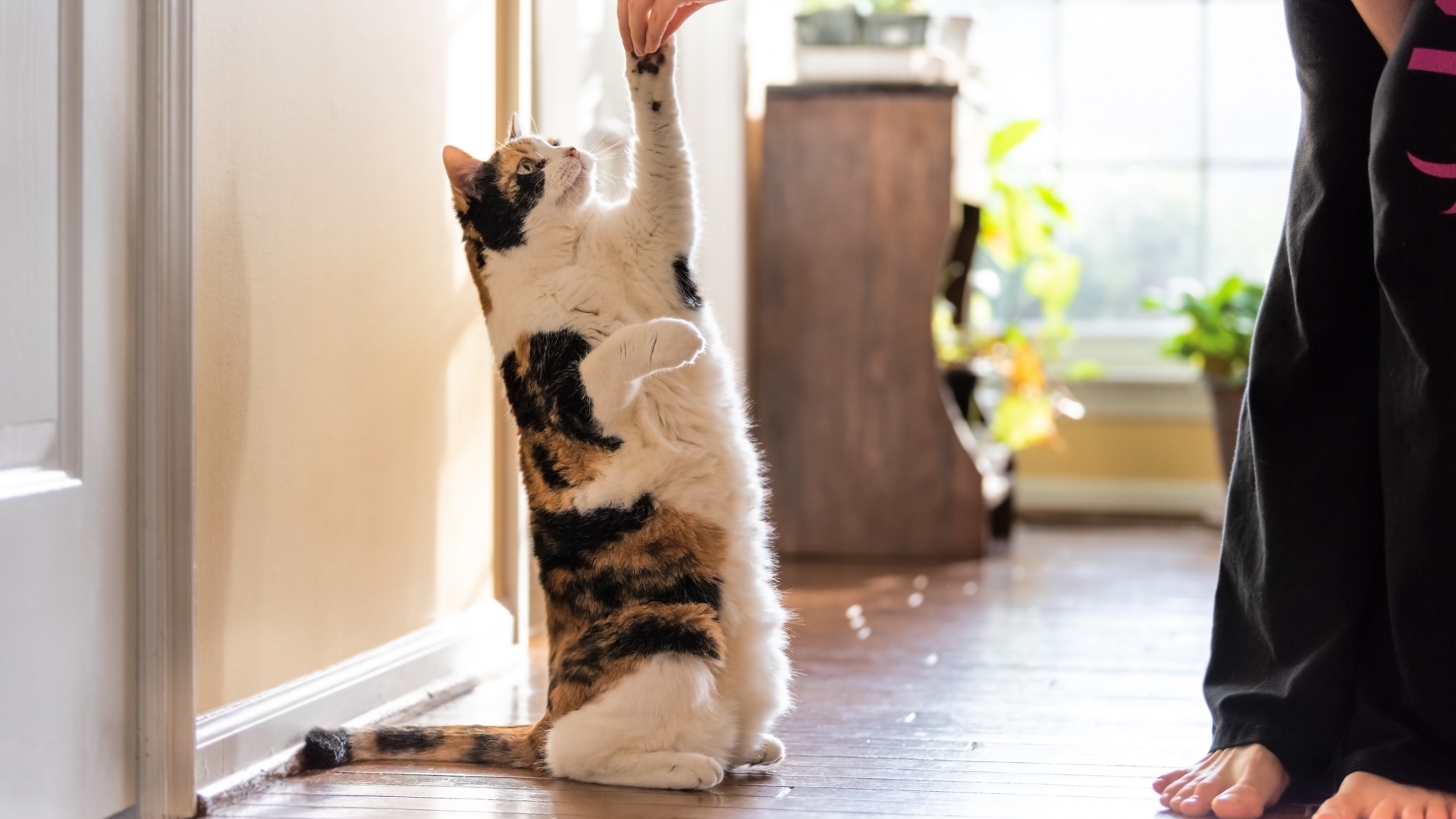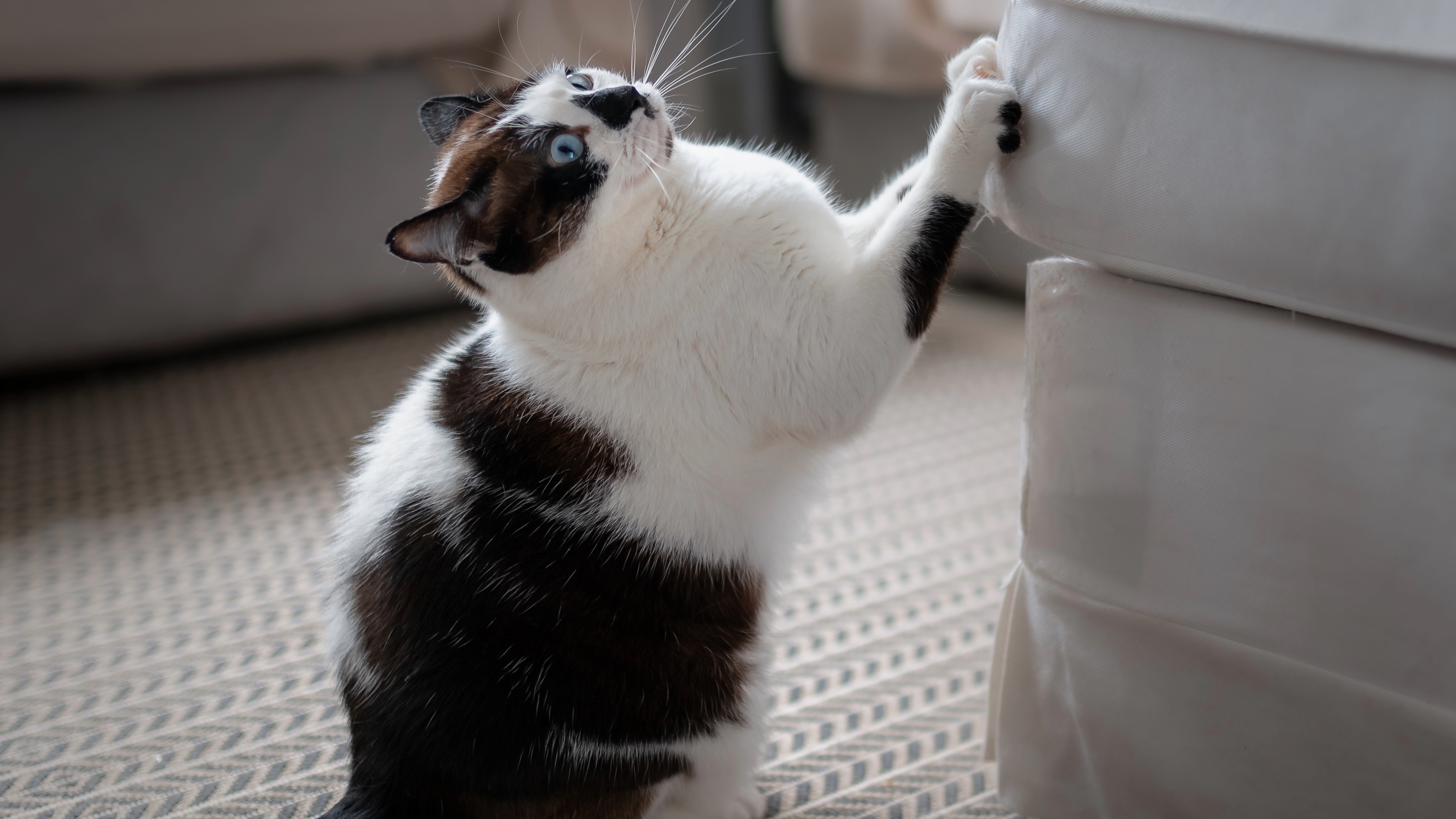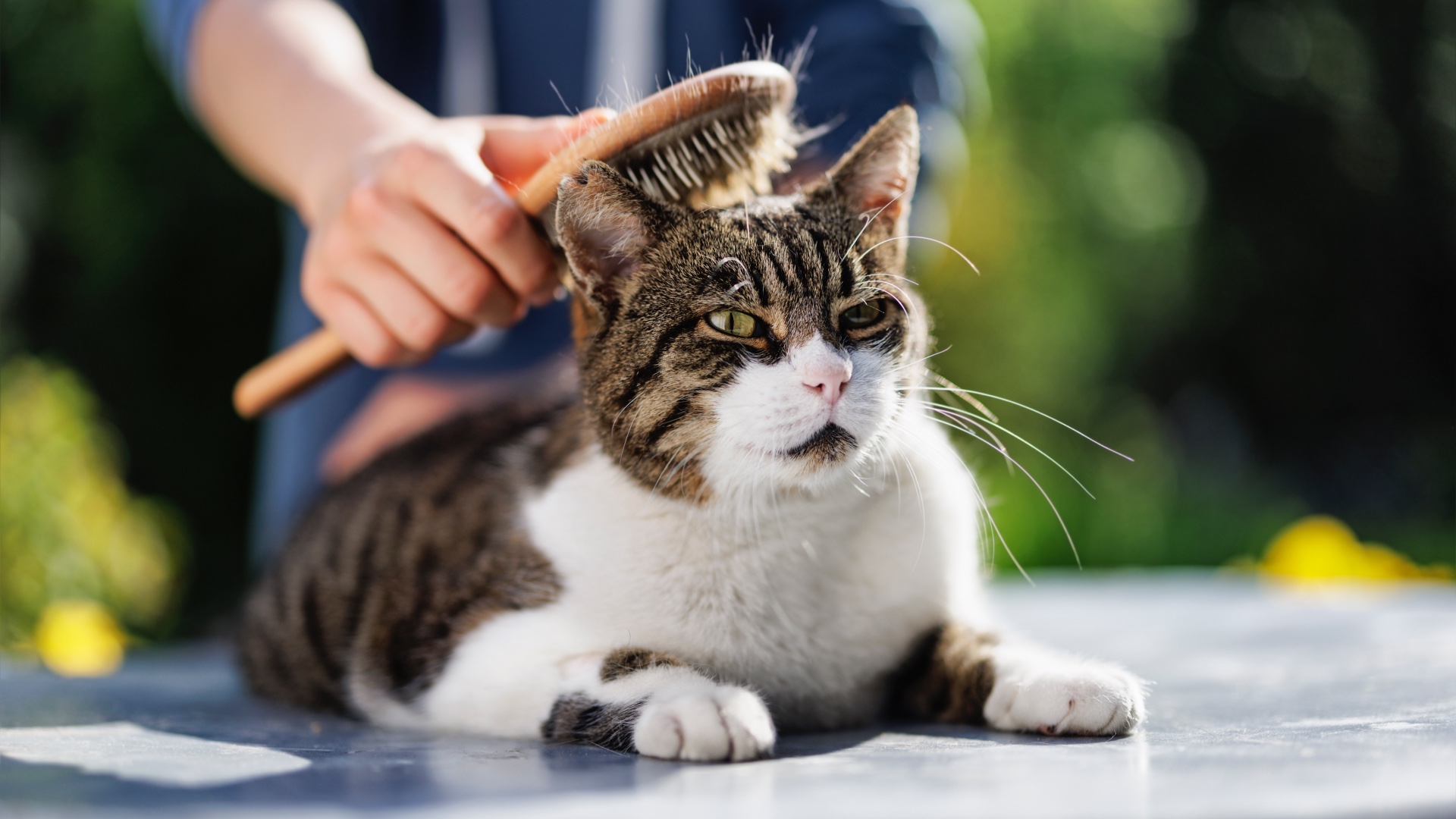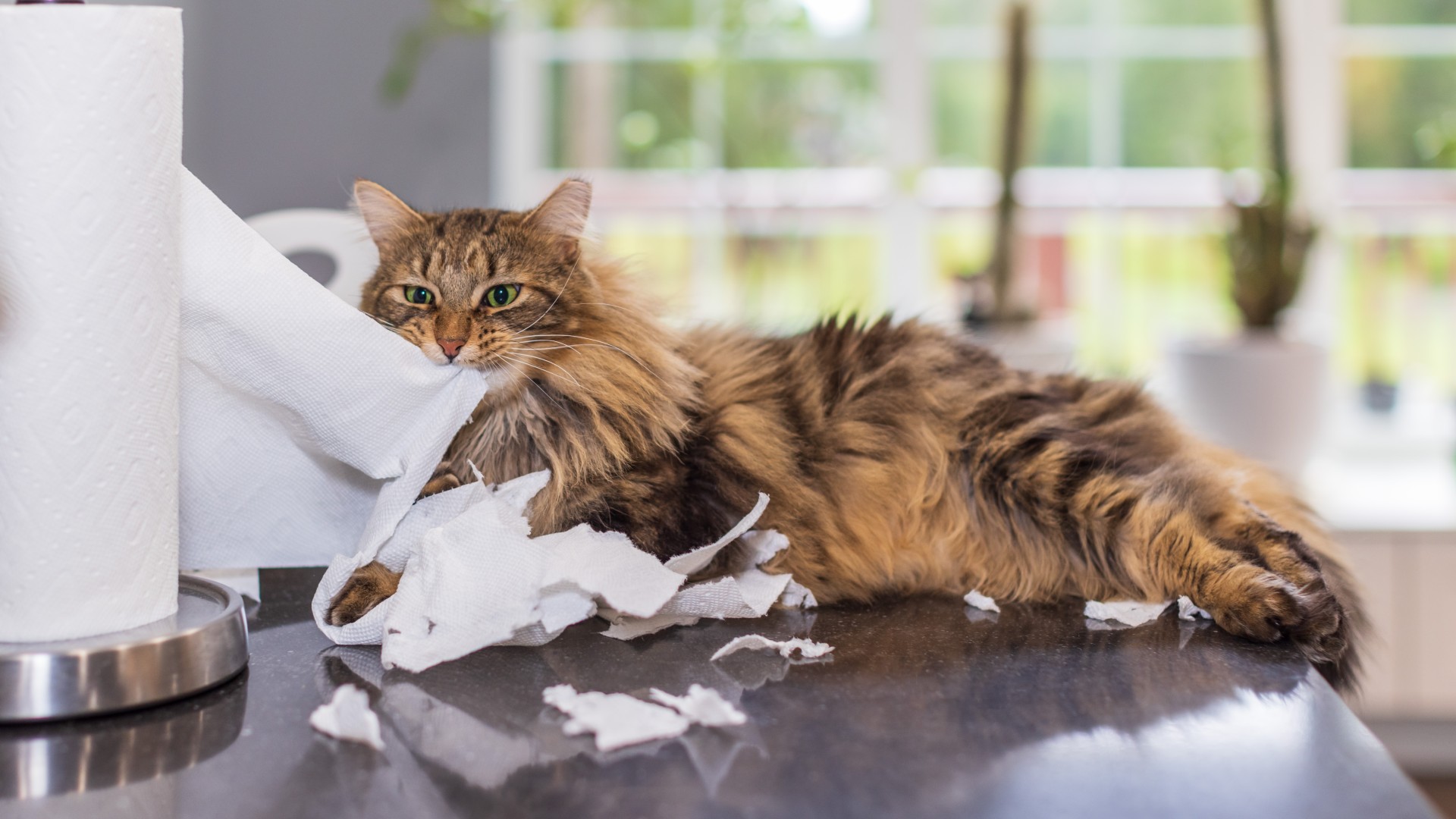32 reasons to train your cat
Looking for reasons to train your cat? You'll find plenty in this guide — and some of them may just surprise you!

Looking for reasons to train your cat? Well, look no further because you'll find a whole bunch of them right here!
Training can help your cat feel more comfortable getting into their carrier, make grooming that much easier, and ensure those twice-yearly vet checkups are as stress-free as possible. Plus, if you use the best interactive cat toys or treats as a reward, you'll help them learn that much faster.
When you ask people the question 'Can you train a cat?', most would answer no — but it turns out that our intelligent feline friends can learn all sorts of new skills, tricks, and behaviors. As long as you use positive reinforcement, you'll find your cat is capable of almost anything.
If you're looking for a little motivation to get you jumping on the training wagon, here are some great reasons to train your cat (and some of them may just surprise you!).
32 reasons to train your cat
1. It will give their brain a good workout

Whatever training you undertake with your cat — whether it's teaching them to walk on a leash, do a trick, or figure out how to solve the best cat puzzle feeder to release their dinner — you're guaranteed to be giving your feline friend's brain a great mental workout. Cats need to exercise their minds the same way we humans do and anything that requires them to learn something or problem-solve is a fantastic way of ticking that box.
2. It's great for increasing their physical activity

With the best dry cat food and wet food being so darn delicious, weight gain is always a potential problem for cats, particularly if they live purely indoors. Many cats don't get anywhere near enough exercise, so doing training that involves movement (like getting them to jump to the top of their cat tree or go under and over objects) is a fun way to get them moving.
3. Training can be a great way to prevent boredom

Have you ever found yourself asking questions like 'why do cats suck on blanekts?' or 'why do cats eat hair?' Because many cats spend the bulk of their lives indoors, it's very easy for boredom to set in and behaviors such as these might be the result. Without plenty of physical and mental stimulation, cats can start to engage in destructive behaviors to get their needs met or become depressed or overweight. Training is a great way to banish boredom by providing them with an activity that's fun and enriching.
PetsRadar Newsletter
Get the best advice, tips and top tech for your beloved Pets
4. You may just find their sleep improves

Learning any new skill or behavior takes a lot of mental energy. If you have a cat that's crying a lot or just won't settle, doing some training can help to tire them out so that they can relax and get the sleep they need to stay happy and healthy. Training your cat in the evening is particularly useful if they're prone to keeping you awake — if you tire them out mentally and physically before you go to sleep, they're more likely to sleep too.
5. It can help strengthen your bond

When you're training your cat, you're doing something together — which is a wonderful way to deepen the bond the two of you share and work on how you communicate with each other. And because you'll be using lots of positive training techniques (like praise and the best cat treats), they'll quickly come to associate you with good things.
6. You and your cat can show off to friends and family

Who doesn't love watching a cat perform a trick or two? We know we do! Showing your friends and family your cat's latest trick can be a great way of bringing everyone together — and if your feline friend isn't quite sure about being around new people, having visitors dish out the treats as a reward can help break the ice.
7. It may just save your furniture

Wondering how to keep cats from scratching furniture? Training is definitely the answer! Cats tend to scratch the furniture when they're stressed, bored, wanting attention, or when there's no suitable scratching alternative, so training and rewarding them for using a designated scratching post will ensure your couch stays free from claw marks. Investing in one of the best cat scratching posts is well worth the money for this reason alone.
8. Training can help your cat to use their litter box

A huge reason to train your cat is to ensure they always pee or defecate in their litter box and not around the house. When it comes to how to litter train a kitten or a cat, make sure you select the best cat litter and litter box location, clean the litter box regularly, and if you have a multi-cat home, purchase several litter boxes to limit competition.
9. It's a great way to boost your cat's confidence

Just like every human has certain things they fear, so does every cat. It could be going to the vet or the sound of the vacuum cleaner, but whatever the trigger, it's likely your feline friend has one or two things that make them feel stressed or anxious. Training around these triggers where your cat learns to form positive associations around things they previously found scary, can do wonders for their confidence and even reduce anxiety in cats.
10. You'll find it easier to handle them

While some cats (like the most affectionate cat breeds) will jump happily into your arms at the first invitation, others aren't quite so fond of being handled. Training your cat to accept handling can make all sorts of situations easier — like those twice-yearly vet visits!
11. Training can reduce stress and anxiety

Cats can experience stress and anxiety for many reasons. It may be related to a particular health issue they’re having, changes that are being made in their environment, or having to go in the car to get a check-up at the vet. Anxiety can lead to a whole host of problematic behaviors, but training can help to dampen down your cat’s stress response, this is just one of many ways to destress your cat.
12. You can teach your cat not to pester you

Whether they’re after more food or simply demanding attention, cats are persistent when they’re after something! Excessive meowing, getting under your feet, jumping up on surfaces, or scratching furniture are all ways your kitty may pester you to get what they want. Training can put a stop to these behaviors and help your kitty learn the art of patience.
13. It can put a stop to biting and scratching

Is your adult cat or kitten biting you? Do they scratch when you pet them, groom them, or try to pick them up? Cats may bite because they’re practicing their predatory instincts, when fearful, stressed, or frustrated. However, with patience and nurturing you can train your cat to regulate their intense emotions and put a stop to this behavior.
14. You may find grooming them is a whole lot easier

While most of our feline friends enjoy being brushed, some don’t and the last thing you want to be doing with your time is reading up on grooming aggressive cats! Thankfully, with a little bit of training, most cats can learn to enjoy being handled, and using one of the best cat brushes doesn't hurt.
15. It will keep them off surfaces you don't want them on

Cat constantly on the kitchen counter? What about your dining room table? Or perhaps it’s more the bathroom sink your little one enjoys hanging out on? Whatever the situation, there are likely surfaces you don’t want your curious cat on — and that’s okay! Training can ensure that all four paws stay on the ground at all times.
16. Training will always be more successful than punishment

Negative reinforcement (yelling, scolding, or being rough with your cat) never works. It may appear to put a stop to the behavior in the short term, but all punishment does is damage the relationship you share with your feline friend. Positive reinforcement on the other hand (offering praise and treats when your cat does something you want to see more of) is something cats respond very, very well to. Do this consistently and you'll create an environment where your cat finds it easy to learn what's expected of them.
17. You'll find it easier to keep them safe

If you plan on letting your feline explore the great outdoors, you'll want to know how to measure a cat for a harness and which of the best cat harnesses you should try out. Doing harness training with your kitty is a great way to keep them safe when they're out in nature's big backyard. It lets them enjoy all the enrichment your garden has to offer while allowing you to keep them safe at the same time.
18. Getting them into their carrier will be easier

One of the biggest challenges faced by cat owners is trying to figure out how to get their cat into their carrier without ending up with both of their arms covered in kitty claw marks! Our feline friends do not like being in an enclosed space that they haven’t entered voluntarily even if it is one of the best cat carriers, so training your kitty to get comfortable with their carrier will make those trips to the vet that much easier.
19. You'll be able to take them on vacation with you

Vacations aren’t just for dogs, cats love them too! And if you have a well-trained cat who’s been taught that traveling is nothing to fear, you’ll find you’ll be able to take your calm kitty on buses, trains, and planes — although do check with your local transport operator first to ensure they’ll accept your fur friend.
20. Your cat will come when you call them

Teaching your cat to come when you call them isn’t just handy, it could also save their life if they’re normally an indoor cat who escapes outside or if they’re somewhere they shouldn’t be. Teaching your cat to come on command means you can rest easy knowing you can always get hold of them if you need them.
21. Training can help make clipping their nails a lot less stressful

Cat nail clipping is something a lot of pet parents fear, and for good reason — many cats find it stressful and if they struggle, there’s always the risk of over-clipping. The good news is, that you can train your cat to at least tolerate those nail sessions and to remain calm and relaxed. Having the best cat nail clippers will also make your job a whole lot easier.
22. It provides vital enrichment for senior cats or those with limited mobility

As our feline friends age and start to slow down, it can be hard to know how to provide them with the physical and mental stimulation they need to stay happy and healthy in their old age. That’s where training comes in. Helping them learn a new skill is a great way to offer up some enrichment and you can get some gentle movement in there too, so you’re ticking both boxes.
23. Training can promote quiet and calm behavior

If you have a hyper kitty on your hands who’s constantly bouncing off the walls and running all over the place, training can be a great way to teach your feline friend that what gets rewarded is quiet and calm behavior.
24. It can slowly reduce aggression

There are various causes of aggressive behavior in cats. Sometimes it’s status, petting, play, or pain-induced and other times it’s related to your kitty feeling fearful or territorial. Whatever the cause, when it comes to how to calm an aggressive cat, training is key to slowly changing behavior.
25. So they can be a support animal

It’s not just dogs that make great support animals, cats are fantastic at this job too! Cats often feature prominently in lists of the best emotional support animal breeds and for good reason — with the right training, these loving and affectionate creatures can make for the most therapeutic of companions.
26. It will help them cope better at the vet

Most cats are reluctant vet-goers (at best!) but with some patience and consistent training you may find that your kitty can tolerate their twice-yearly checkups with relative ease.
27. Training can help them get used to car journeys

Cats are notorious for detesting having to go in the car, and for good reason — they tend to get motion sickness. However, training can help to alleviate some of the stress and anxiety that many experience which will help make the whole process a lot more relaxing (for both them and you!)
28. Helps multi-cat households run smoothly

Wondering how to keep the peace in a multi-cat household? It all comes down to training. When you use treats, play, and attention to reinforce positive behavior in your cats, you cement yourself as the dominant personality in the house — which means all of your feline friends stay on a level playing field.
29. Boosts happiness

If you start to train your kitty to learn news skills and behaviors, you're almost guaranteed to begin spotting all the signs of a happy cat — that's because just like us humans, our feline friends love learning new things. So, if you want to give your cat's happiness a boost and ward off anxiety and depression, training is a great place to start.
30. You can train them to sit on your lap

Granted, some breeds are more prone to cuddling up on your lap than others, but you don't need to have a ragdoll or a Persian to get in a daily snuggle session. Most cats can be trained to spend some time on your lap — even if it isn't always for as long as you'd like!
31. It builds trust

Cats crave routine and predictability. When you train them consistently using positive reinforcement, you're communicating to them that they've done something good, which is a wonderful way to earn their trust.
32. To show people what cats are capable of

We all know how amazing dogs can be at learning new tricks and mastering new skills, but we often write cats off and think they can't possibly be taught how to fetch an item or take part in an agility course. Not true. Our feline friends are super intelligent and they are more than capable of learning many of the same things that dogs are — they're just very independent minded, so whether they want to be trained is a decision entirely in their paws!

Kathryn is a freelance writer who has been a member of the PetsRadar family since it launched in 2020. Highly experienced in her field, she's driven by a desire to provide pet parents with accurate, timely, and informative content that enables them to provide their fur friends with everything they need to thrive. Kathryn works closely with vets and trainers to ensure all articles offer the most up-to-date information across a range of pet-related fields, from insights into health and behavior issues to tips on products and training. When she’s not busy crafting the perfect sentence for her features, buying guides and news pieces, she can be found hanging out with her family (which includes one super sassy cat), drinking copious amounts of Jasmine tea and reading all the books.
